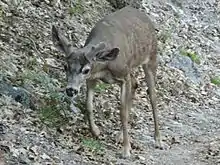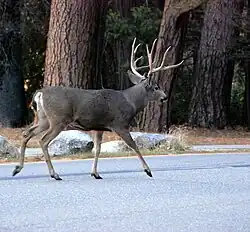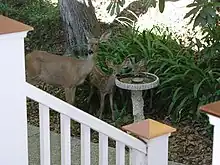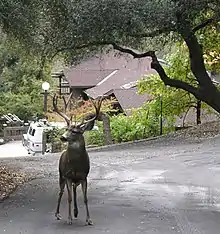California mule deer
The California mule deer (Odocoileus hemionus californicus) is a subspecies of mule deer whose range covers much of the state of California.[1]
| California mule deer | |
|---|---|
 | |
| A young buck in Yosemite National Park | |
| Scientific classification | |
| Domain: | Eukaryota |
| Kingdom: | Animalia |
| Phylum: | Chordata |
| Class: | Mammalia |
| Order: | Artiodactyla |
| Family: | Cervidae |
| Subfamily: | Capreolinae |
| Genus: | Odocoileus |
| Species: | |
| Subspecies: | O. h. californicus |
| Trinomial name | |
| Odocoileus hemionus californicus (Caton, 1876) | |

Anatomy
One of the principal means of distinguishing the closely related black-tailed deer and white-tailed deer is the growth habit of the buck's antlers. In the case of the Black Tail and California mule deer, the antlers fork in an upward growth, whereas the other species' antlers grow in a forward direction.[2] These antlers consist of two main beams that then each fork into two tines. Further forking is dependent upon age, genetics, and nutrition. They will shed these antlers around mid-February and regrow them throughout the Spring.The mule's anatomy is characterized by large ears and a black-tipped tail. The ears, which resemble those of a mule, are where the mule deer gets its common name. The mule deer's physical measurements range from a height of 31- 42 in to their shoulders, a length of 3.9 to 6.9 feet nose to tail, and an average weight of 200 lbs in males and 150 lbs in females.[3][4]
Distribution
This subspecies, O. h. californicus, is widespread throughout northern and central California in the California coastal prairie, as well as inner coastal ranges and interior mountains, especially the Sierra Nevada. This deer is much less frequently found on the floor of the interior valleys, and then mostly frequently in riparian zones.[5] Additionally, mule deer are migratory mammals. In northern areas including Inyo and and Mono counties, their summer ranges are typically located at higher elevations and are characterized by a higher plant density for foraging and fawning areas. They will migrate to lower elevations with more limited food during the winter as the higher elevations become covered with snow. In more southern areas of California including the San Bernardino mountains this migratory shift consists of seasonal elevations migrations rather than a complete shift in ranges.[4]
Habitat
The California Mule deer's habitat generally consists of hilly terrain in oak woodlands.[3] They are abundant throughout Sequoia, King's Canyon, and Yosemite national parks as well as their surrounding areas.[6]
Diet and behavior
California Mule deer are herbivorous and often browse for food within a 1-2 mile radius of a water source (including rivers and lakes) which creates a feeding area that is often located in or around shaded grassy areas upon which they will make their beds.
They will participate in a behavior where they create beds to sleep on. These beds are roughly 2 meters in diameter and often appear as flatted grassy areas. However frequently used and re-used beds may appear significantly more level and decomposed compared to their surrounding environment.[3] This behavior is often observed among bucks during the later fall season as temperatures drop. They will choose a sunny spot, remove any rocks or branches, and take a nap. These beds are often located on grasses or dry leaves under a tree or a rock, or on flattened areas of snow if there is nothing else available.[6]
Mule deer are often opportunistic and will consume a large variety of vegetation mainly consisting of whatever is available and easily digestible including stalks, flowers, fruits, seeds of grasses, forbs, buds, seeds (particularly acorns), stems, leaves, the bark of trees, shrubs, fungi, lichens, algae, mosses, and ferns. Because of their opportunistic nature, they will adjust their diet in accordance to what is available given various factors including snow and fire. In summer, California mule deer mainly browse on leaves of small trees, shrubs, and herbaceous plants, but also consume many types of berries (including blackberry, huckleberry, salal, and thimbleberry). In winter, they may expand their forage to conifers (particularly twigs of Douglas fir), aspen, willow, dogwood, juniper, and sage. Year-round, they feed on acorns; grasses are a secondary food source. Where humans have encroached on historic deer habitat by suburban development or orchards, California mule deer diversify their diet with garden plant material, tree fruit, and occasionally, pet food.[3][7]
Fawns and does tend to browse together in familial groupings, while bucks tend to travel singly or with other bucks. California mule deer browse most actively near dawn and dusk, but also forage at night in open agricultural areas or when experiencing hunting pressure.[3]
Mule deer will often form family groups made up of 2 or more generations of females and their fawns. Grown bucks leave these groups and will occasionally form groups with other adult bucks but are more often observed living solitarily. Females will spend their summers isolated in fawning areas after their young have sufficiently grown, where they will remain until the breeding season begins again in the fall.[7]

Breeding
Mule deer have been classified as occasionally polygamous and occasionally polygynous. The males have sometimes been observed wandering extensively, seeking out females, and occasionally does will seek out a dominant buck who will tend to them until breeding. In either system, larger bucks with large antlers tend to be the most dominant individuals in a community.[7]
Rutting season occurs in autumn starting as early as September and lasting occasionally until March. During this time, the does will come into estrus for a period lasting only several days. Males exhibit aggressive behavior in competing for mates. Does begin estrus again if they do not become pregnant in a process that will be repeated up to 5 times with intervals of 22-29 days between estrous periods. The gestation period is about 200 days, with fawns arriving in the spring; the young remain with mothers throughout the summer and are weaned in the autumn. The buck's antlers fall off in the winter, and commence growing once more in spring in anticipation of next autumn's rut.[3][7]
Predation
The largest predator of the California Mule deer is the Mountain Lion which will often prey on weak, sick, or young deer with the occasional exception of hunting large healthy deer. Additionally, bobcats, coyotes, and Black bears can hunt mule deers but often only attack fawns or scavenge on the remains of dead deer.[3]
Disease and Parasites
The California mule deer often falls victim to the woodtick, which is extremely common throughout its habitat. Additionally lungworms and the nasal botfly will enter and parasitize the deer's lungs and nasal passageways. Parasitic eye worms of the genus Thelisa or Thelazia have also been found parasitizing the deer.[6]

Human interactions
Since prehistoric times, the Native American indigenous peoples of California are known to have hunted California mule deer. Thus, since about 12,000 BCE, Gage suggests that human populations have served as a control to the numbers of California mule deer.[8]
In the modern era, since European colonists and Euro-Americans settled in California, hunting pressure intensified as the human population expanded and hunting became an activity not just associated with food supply. In addition, human population growth (through urban development) in California has consumed large amounts of natural habitat of the California mule deer starting in the late 19th century and continuing through the present.
References
- U.S. Forest Service distribution Map — Odocoileus hemionus (Mule Deer) — including subspecies californicus . accessed 3.39.2013.
- Taylor, Walter P., "The Deer of North America" Stackpole Company. Harrisburg, PA. (1956)
- "California Mule Deer - OVLC". OVLC - Protecting your views, trails, water and wildlife. 2014-07-10. Retrieved 2023-10-25.
- "Mule Deer (Odocoileus hemionus)". wildlife.ca.gov. Retrieved 2023-10-10.
- Clark, Howard (2004). "Occurrence of California Mule Deer in the Southern San Joaquin Valley, California" (PDF). Transactions of the Western Section of the Wildlife Society. 40: 127–128.
- "Wildlife Portfolio of the Western National Parks (California Mule Deer)". www.nps.gov. Retrieved 2023-10-25.
- "Odocoileus hemionus". www.fs.usda.gov. Retrieved 2023-10-25.
- Gage, Timothy (1979). "The competitive interactions of man and deer in prehistoric California". Human Ecology. 7 (3): 253–268. doi:10.1007/BF00889494. S2CID 89106860.
External links
- U.S. Forest Service treatment — Odocoileus hemionus (Mule Deer) — including subspecies californicus